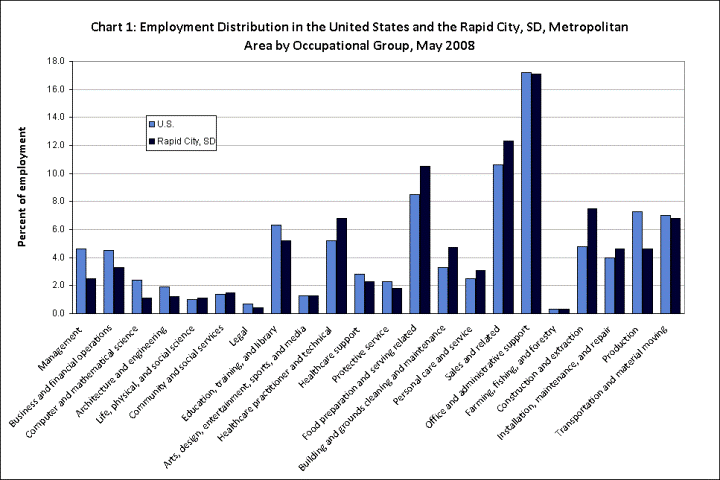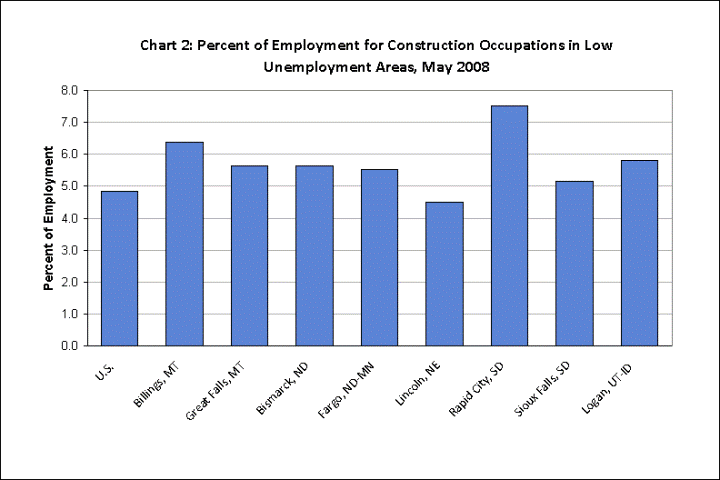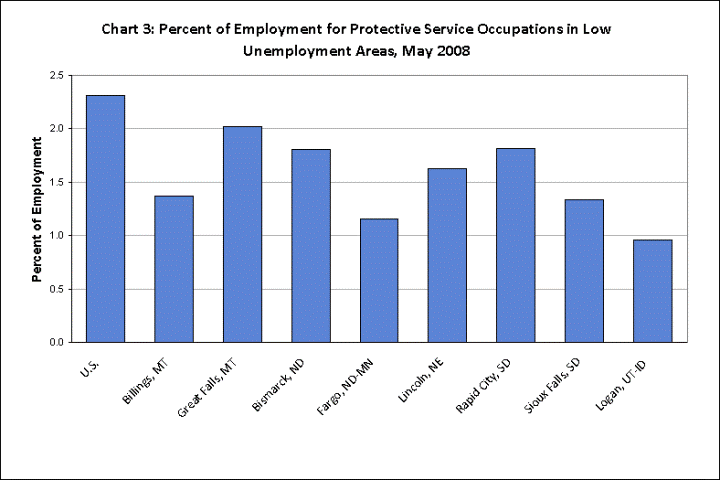An official website of the United States government
 United States Department of Labor
United States Department of Labor
September 2009
In August 2009, there were fewer than ten metropolitan areas in the United States with unemployment rates below five percent.1 As unemployment began rising in the rest of the country, occupational employment and wages in these areas differed from that of the U.S. For example, these areas generally had higher concentrations of employment in healthcare practitioner and technical, food preparation and serving, sales and related, and construction and extraction occupations. They generally had lower employment shares of computer and mathematical science; architecture and engineering; legal; education, training, and library; and protective service occupations. All had average wage rates below the national average.

Click here to see these data in table format.
The employment distribution in Rapid City, SD, shown in chart 1 along with the employment distribution in the U.S., illustrates the employment pattern typical of these areas.

Click here to see these data in table format.
Seven out of the eight areas had higher concentrations of employment and lower wages in construction occupations. (See chart 2.) Construction occupations made up almost six percent of employment in these eight areas combined, compared with a little less than five percent nationally. Carpenters were the largest contributor to these high employment concentrations, accounting for the largest difference in employment shares among construction occupations in six of the eight areas. Mean wages for construction workers were below the national average in all eight areas, ranging from 15 percent lower in Fargo, ND-MN, to 34 percent lower in Rapid City, SD, where the concentration of construction workers was the highest.
Sales and related occupations accounted for 10.5 percent of employment nationwide, but 11.5 percent of employment in the areas with the lowest rates of unemployment. All of these areas except Lincoln, NE, had above average concentrations of employment in sales and related occupations. Retail salespersons were the largest occupation in this group. Mean wages for sales and related occupations ranged from two to 40 percent lower than average in these eight areas.

Click here to see these data in table format.
All eight areas had below average employment shares of protective service occupations. (See chart 3.) Protective service occupations made up only 1.5 percent of employment in the eight areas with the lowest unemployment rates combined, compared to 2.3 percent of U.S. employment. This difference was largely due to relatively low employment concentrations of security guards. Although mean wages for protective service occupations were lower than the national average in all eight areas, the wage difference was not as great for this occupational group as for other groups.
Education, training, and library occupations accounted for about 6.3 percent of U.S. employment, and about 5.4 percent of the combined employment in the eight areas. Logan, UT-ID, a university town, was an exception, with 9.3 percent of employment in education, training, and library occupations. Mean wages for education, training, and library jobs were again lower than the national average, but in six of the eight areas, the wage difference was smaller than for other occupational groups.
Employment concentrations in office and administrative support and production occupations showed high variability among the areas. On average, production occupations had lower employment shares in these areas than in the U.S. Great Falls, MT, had less that half the average employment concentration, while Logan, UT-ID, had more the double the average share of employment in production occupations. Six of the areas had lower shares of employment in production occupations than did the U.S. Mean wages for production occupations in the eight areas were much closer to the U.S. average wage than most of the occupational groups. Billings, MT, and Bismarck, ND, had higher mean wages for production workers than the national average.
The share of office and administrative support workers in the eight areas overall was 1.3 percentage points higher than their share of U.S employment. However, three areas had below average concentrations of employment in this group. Mean wages for office and administrative support workers were at least nine percent below the national average.
Data on local area unemployment rates come from the Local Area Unemployment Statistics program; national unemployment rates are available from the Current Population Survey. Complete OES data, including occupational employment and wages for the eight low unemployment areas, can be found on the OES home page. This highlight was prepared by Ben Cover; for more information, please contact the OES program.
1 This highlight focuses on the eight areas with August 2009 unemployment rates below five percent for which May 2008 OES data were available: Billings, MT; Great Falls, MT; Bismarck, ND; Fargo, ND-MN; Lincoln, NE; Rapid City, SD; Sioux Falls, SD; and Logan, UT-ID. No OES data were available for Manhattan, KS, which also had an August 2009 unemployment rate below five percent.
Last Modified Date: October 22, 2009